|
|

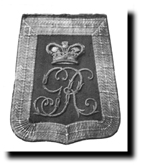 |
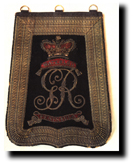 |
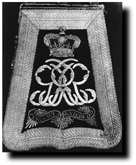 |
| 1810 | 1816 | 1825 |
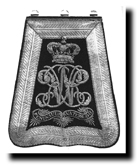 |
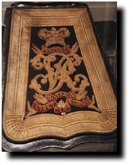 |
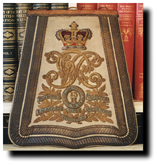 |
| 1830 | 1845 | 1861 - 1910 |
| These six sabretaches show the development of this accoutrement over the 19th century. Although they became a decorative appendage to the officer's outfit, they were originally quite useful for carrying paperwork, maps, etc. as uniforms at the time had become very tight-fitting. The light dragoon style of sabretache was generally this shape, the heavies had single curved base to their sabretaches. The colouring for the black and white pictures can be taken as similar to the 1816 and 1845 versions. The style of lace round the edge is the same throughout the period that sabretaches were worn (they were abolished in 1902). It is 'train' pattern and remained gold. The royal cypher is that of George III for the first two, but the second one has the honours for Waterloo and Penninsula. The c1825 version has the more sophisticated reverse cypher of George IV and is identical to the sabretache worn by the officer in the Dighton painting of 1825. The 1830 one has William IV's cypher with the same arrangement of honour scrolls as before, but in 1836 the regiment had it's motto restored to it: Viret In Aeternum and this was added to the design. This was short-lived as William died in 1837, bringing in c1845 sabretache with the VR cypher. The 13th gained 4 battle honours in the Crimean War but the sabretache was discontinued between 1855 and 1861 so they were unable to display them. The 13th were converted to Hussars in 1861 and a new design was adopted with a background colour the same as their facings (pale buff). The motto was put in a circle under the cypher and the honours were, clockwise from the right, Waterloo, Inkerman, Sevastopol, Alma, Balaklava and Penninsula. The lace round the edge at this time had a buff silk stripe down the middle. |
Armed Forces | Art and Culture | Articles | Biographies | Colonies | Discussion | Glossary | Home | Library | Links | Map Room | Sources and Media | Science and Technology | Search | Student Zone | Timelines | TV & Film | Wargames
